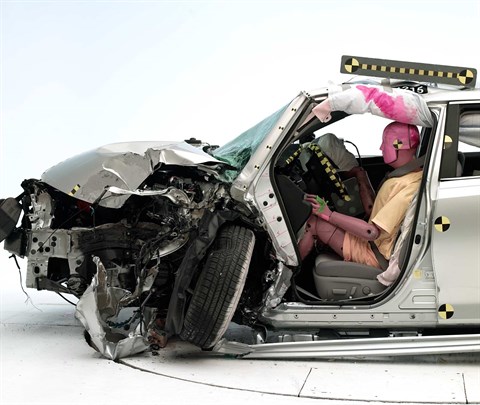Small overlap front: driver-side
Rating applies to 2012-14 models built before January 2014
Tested vehicle: 2012 Toyota Camry LE 4-door
The Toyota Camry was redesigned for the 2012 model year.
| Evaluation criteria | Rating |
|---|---|
| Structure and safety cage | |
| Driver injury measures | |
| Head/neck | |
| Chest | |
| Hip/thigh | |
| Lower leg/foot | |
| Driver restraints and dummy kinematics The dummy’s head barely contacted the frontal airbag before sliding off the left side as the steering column moved 19 cm to the right, resulting in little airbag cushioning for the chest. Additionally, the seat belt allowed excessive forward excursion of the dummy’s head and torso, contributing to the head hitting the instrument panel. The side curtain airbag deployed but does not have sufficient forward coverage to protect the head from contact with forward side structure and outside objects. The side torso airbag deployed. | |

Action shot taken during the small overlap frontal crash test.

The dummy's position in relation to the door frame, steering wheel, and instrument panel after the crash test indicates that the driver's survival space was not maintained well.

During the crash, the dummy's head barely contacted the frontal airbag before sliding off to the left as the steering column moved to the right. The seat belt allowed the dummy to move too far forward, as is evident from the gap between the seat back and the dummy's torso, and the head hit the instrument panel. The side curtain airbag did not extend far enough forward toward the A-pillar.

Intrusion into the occupant compartment was extensive. The door hinge pillar began to tear as the wheel and tire was pushed back, and this intrusion combined with that of the parking brake pedal and instrument panel contributed to a moderate risk of injury to the left lower leg.
Moderate overlap front: original test
Rating applies to 2012-17 models
Tested vehicle: 2012 Toyota Camry LE 4-door
The Toyota Camry was redesigned for the 2012 model year. Frontal ratings are assigned by the Institute based on a test conducted by Toyota.
| Evaluation criteria | Rating |
|---|---|
| Overall evaluation | |
| Structure and safety cage | |
| Driver injury measures | |
| Head/neck | |
| Chest | |
| Leg/foot, left | |
| Leg/foot, right | |
| Driver restraints and dummy kinematics | |
Side: original test
Rating applies to 2012-17 models
Tested vehicle: 2012 Toyota Camry SE 4-door with standard front and rear head curtain airbags and standard front and rear seat-mounted torso airbags
The Toyota Camry was redesigned for the 2012 model year. Side ratings are assigned by the Institute based on a test conducted by Toyota.
| Evaluation criteria | Rating |
|---|---|
| Overall evaluation | |
| Structure and safety cage | |
| Driver injury measures | |
| Head/neck | |
| Torso | |
| Pelvis/leg | |
| Driver head protection | |
| Rear passenger injury measures | |
| Head/neck | |
| Torso | |
| Pelvis/leg | |
| Rear passenger head protection | |
Roof strength
Rating applies to 2012-17 models
Tested vehicle: 2012 Toyota Camry LE 4-door
| Overall evaluation | |
|---|---|
| Curb weight | 3,167 lbs |
| Peak force | 15,148 lbs |
| Strength-to-weight ratio | 4.78 |
Head restraints & seats
Seat type: Power cloth seats
| Overall evaluation | |
|---|---|
| Dynamic rating | |
| Seat/head restraint geometry |
About the head restraint & seat test
Currently, IIHS tests apply only to front seats.
